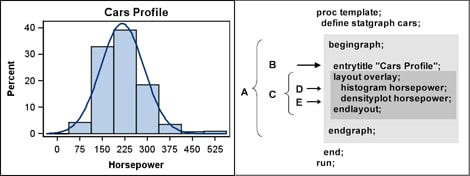The Graph Template Language
Overview
At the
heart of ODS Graphics lies the Graph Template Language. For example,
all of the graphs that are created by the SAS analytical procedures
and by the SAS/GRAPH Statistical Graphics Procedures are generated
using GTL. Users who need to go beyond the graphs created by these
SAS procedures can use GTL directly to design their graphs using the
TEMPLATE and SGRENDER procedures. To successfully create or modify
GTL templates, you need the information in this User's Guide, which
helps you understand important concepts and offers many complete code
examples illustrating often used features. You also need access to
the SAS/GRAPH Graph Template Language Reference, which is
the language dictionary for GTL.
Defining the Graph Template
GTL uses
a structured "building-block" approach to defining a graph. The syntax
provides a set of layout, plot, and other statements to define the
graph. ODS Graph and the Template to Generate It shows a graph of car profiles by horsepower and the syntax necessary
to define the graph using GTL.
The template
definition consists of the following parts:
| A. The GTL syntax block from BEGINGRAPH to ENDGRAPH. |
| B. The title for the graph. |
| C. The LAYOUT OVERLAY block. The results of the statements in this block are overlaid in the graph. |
| D. A histogram of the horsepower variable. |
| E. A density plot of the horsepower variable. |
Running
the program in ODS Graph and the Template to Generate It creates the CARS template and saves
it in an item store.
Creating the Graph
To create
the graph in ODS Graph and the Template to Generate It, the SGRENDER procedure is run to associate the appropriate
data set with the compiled template:
proc sgrender data=sashelp.cars template=cars; run;
In the
template definition, the HORSEPOWER variable is used explicitly for
the HISTOGRAM and DENSITYPLOT statements. The explicit reference
in the template to a variable named HORSEPOWER requires that the data
set have a numeric column named HORSEPOWER. Using Dynamics and Macro Variables to Make Flexible Templates shows you how to make the template
more flexible.
When GTL is Needed
-
The graphs that are created by the analytical procedures use predefined GTL templates. These templates are designed by SAS procedure writers and shipped with SAS. Every graph created by these procedures has a corresponding template stored in the SASHELP.TMPLMST item store. To customize these templates, you must develop a basic understanding of the GTL.
-
Often analysts need graphs of the data before an analysis can be started. Or, the results of a complex analysis involving multiple procedures or DATA steps need to be presented as graphs. Although many of these tasks can be accomplished using the SG Procedures, those procedures do not provide many of the advanced layout capabilities of GTL. To create such custom graphs, you must develop a basic understanding of the GTL.
